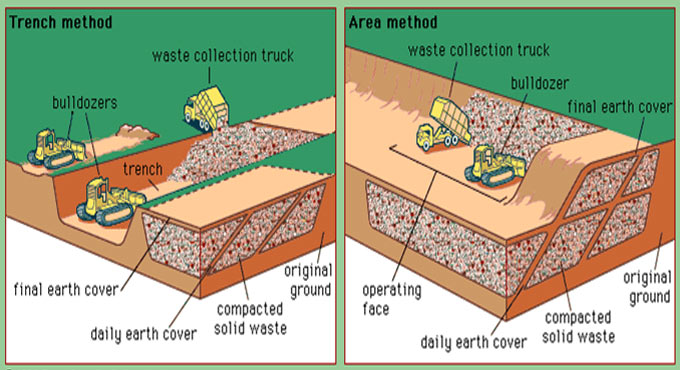
Details of landfills methods

Landfill means an engineered site where waste is separated from the atmosphere underneath the ground or on top unless it is secured and entirely dissolute biologically, chemically and naturally.
Benefits of landfilling:
a. Burying can lead to energy formation with the conversion of landfill gas as for instance methane and CO2.
b. Landfill byproducts are utilized as direct/indirect fuel for combustion.
c. Easy observation because of particular location.
d. It can be reprocessed as well as applied as parks or farming land.
e. All the reusable materials are utilized prior to closing.
f. Organic material is segregated and applied for compost or formation of natural gas.
g. Considerably inexpensive.
Different types of landfills methods :-
1. Area method (over ground level)
a. It is suitable for flat ground or terrain and not suitable for the excavation of trenches.
b. Prior to actual land filling, an earthen levee is built up against which waste are arranged in thin layers and compressed.
c. Depth of layer attains a height of 200 to 300 cm.
d. Cover material with 15 to 30 cm deepness is arranged after every layer.
e. A complete lift along with the cover is defined as a cell.
f. This method is effective for the disposition of huge amounts of solid waste.
2. Trench Method (Underneath ground level)
a. It is suitable where cover material is present at construction site and the water table is located under the surface.
b. Waste are arranged in trench and compressed in thin layers.
c. After the compression of layer, height attains design height and the cover material is arranged over the compressed layer.
d. Some trench is then sustained and filled correspondingly.
e. It is perfect for the areas where the waste is considerably minimum.
3. Depression/Valley Method
a. It is suitable for the areas where natural or artificial depressions remain and these are utilized for land filling.
b. It is based on the geometry of the site as well as geography of the site and entry to site.
c. The general method is to arrange in such a way that the water should not be stored behind the landfill.
4. Slope Method
a. It is effective for hilly areas since flat ground is not available for land filling.
b. Waste is arranged along the sides of current hill slope.
c. Managing incoming water from hill side slopes is a crucial factor for creating the design of such landfills.
d. It is generally applied for flat or little undulating regions.
e. Alteration of both the area and the trench method and employs specific technique of both.


